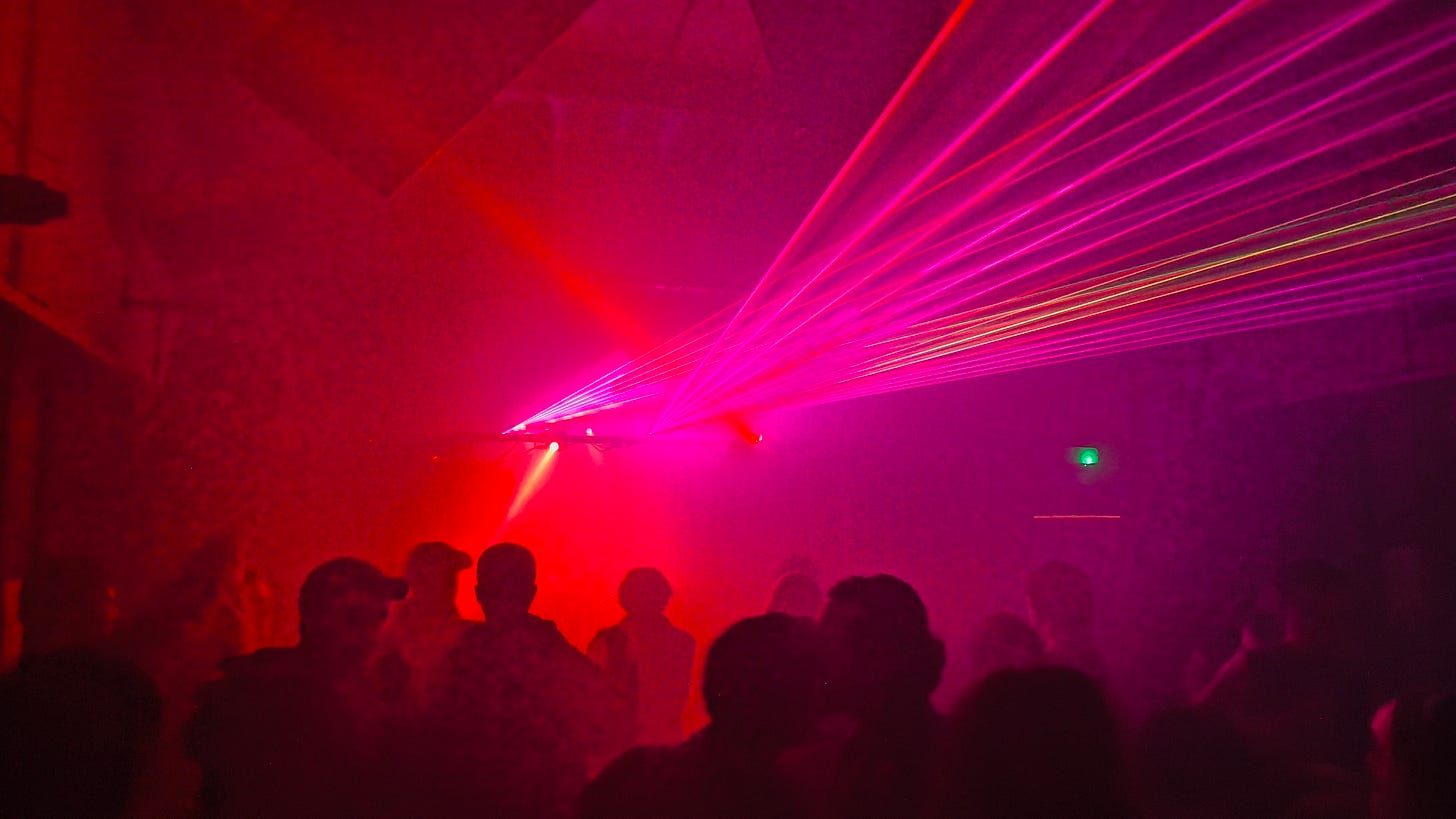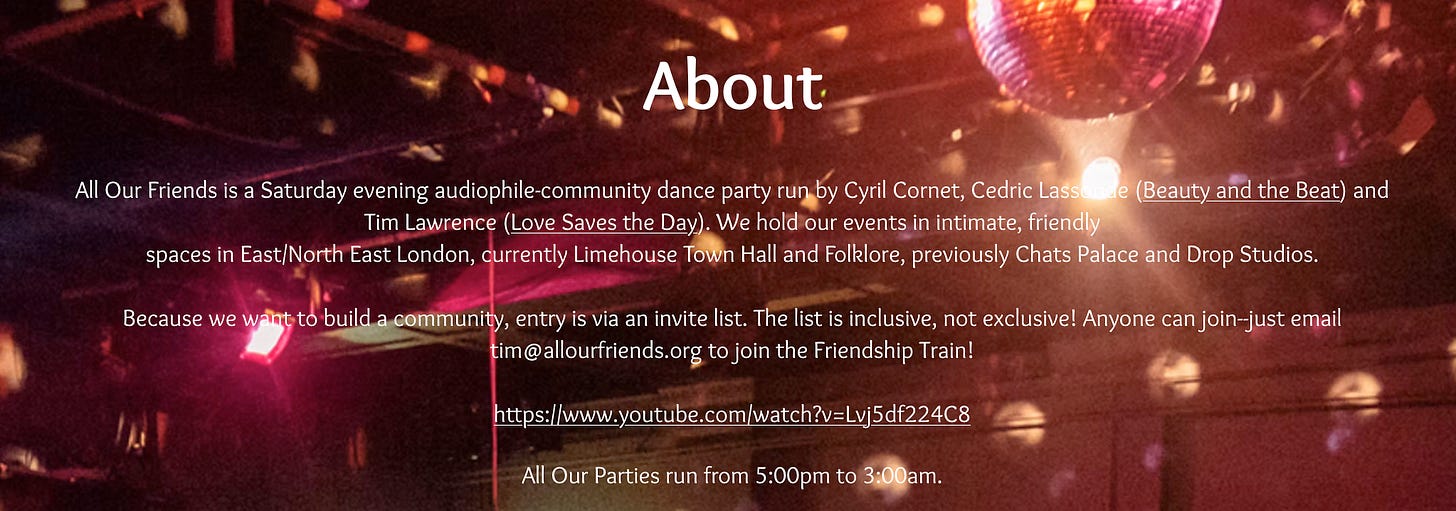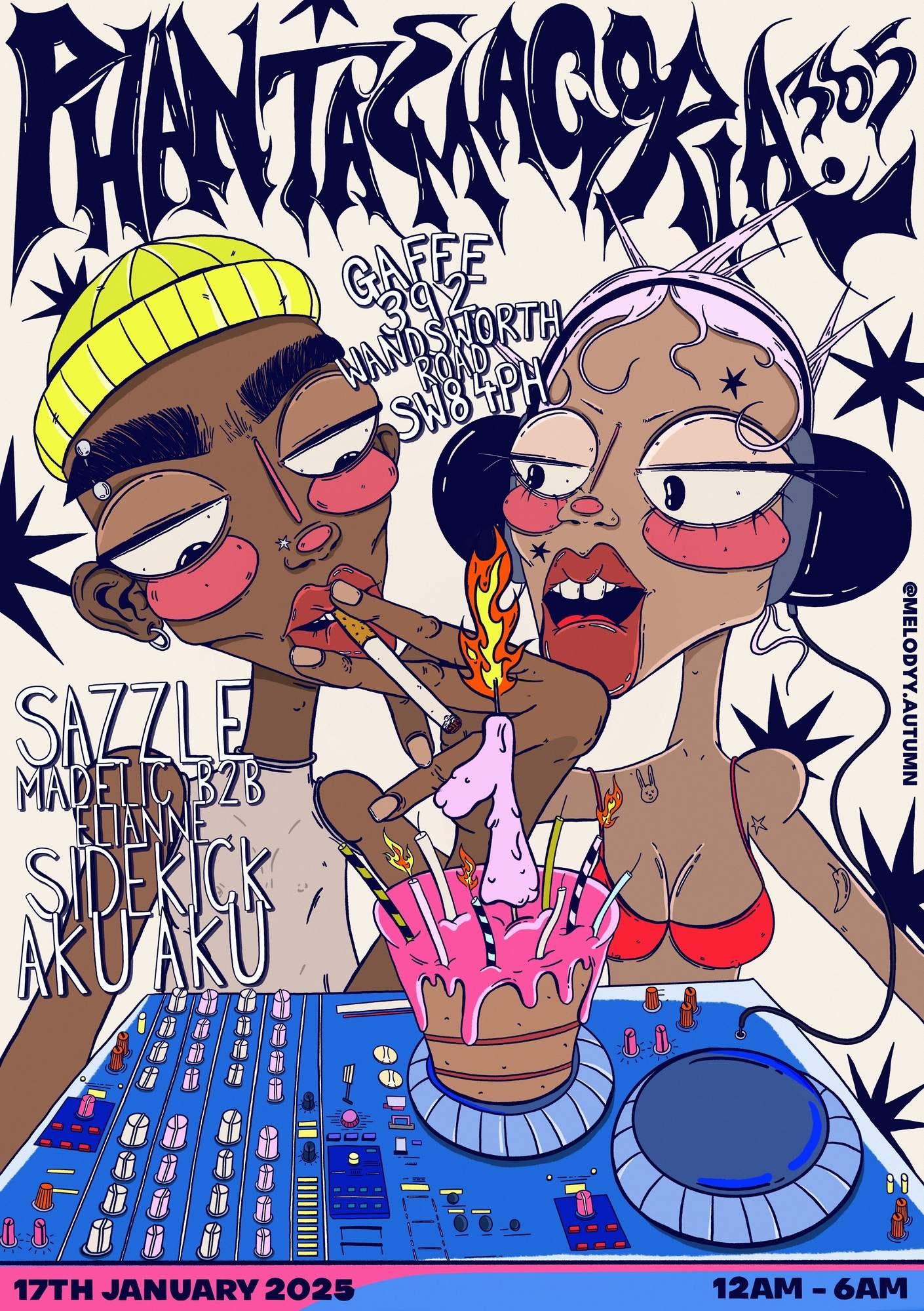Dekmantel, All Our Friends, and Phantasmagoria
It's not all doom and gloom in the nightlife industry
So this is the second part in a mini series I’m doing of my final experiences in London. You can find the first part here.
London has come under heavy fire in recent years about its dying nightlife with the mayor, Sadiq Khan, even creating a new task force to try and combat the issue. The position was previously taken on by the “Night Czar”, Amy Lamé, which came with its own share of controversies.
So the city’s scene doesn’t really look like it's in a great position.
And if you, dear reader, read my last post, it would seem my thoughts on the matter agree with this statement. Drumsheds has been London’s largest nightlife project for quite some time and seeing my peer’s reactions to the venue today suggested to me that it’s not really succeeding at being the change the city needs. Or even giving people hope.
However, in some of my final nights out in London, I think my opinion has been changed.
Let me tell you about where I went.
Dekmantel Club Tour at Venue MOT
If you’ve read my blog before, you’ll know I love both Dekmantel and Venue MOT. The former I went to for the first time last summer, and the latter was a beloved hangout when I lived in London. There’s a lot to love about both.
So when Dekmantel announced their 2024/25 club tour with their London edition at Venue MOT, it felt right to go.
And it was a lot of fun. With Fafi Abdel Nour, Marie Malarie, NVST, and Piezo playing, it had a full range of electronic selections on offer.
But what I wanted to talk about here is how the party really suited the venue, and vice versa.
I’m not sure where I first heard this, but Dekmantel was once described to me as “a festival by DJs, for DJs”. I’ve said this before but everyone who attends, works, and plays at the festival is totally and utterly obsessed with the scene and all it stands for. And this energy is carried well into the festival’s club tour. The lineup selection on that night maybe wasn’t the biggest on the tour but it was well selected and you could tell when each DJ was playing as their unique styles really shone.
And Venue MOT was the perfect place to host it. A theory of mine is that the less accessible a club is by public transport, the better it is. And in my opinion, MOT takes the cake on this. True, it can be a real nightmare to get to and from the venue, but once you’re there, it’s incredible. Everyone else has made the same effort to be there like you so everyone is as into the music as you.
And that’s how I believe the two complimented each other so well. You had:
A party that’s run and attended by people obsessed with electronic music
In a venue whose regulars are obsessed with electronic music
A perfect match up if you ask me.
You could also tell it was working well. The club was full early, no one was drunk and disorderly, people were polite and friendly, the dance floor was easy to navigate, and people stayed long into the night. No walk-ins just looking for a good night and not caring about the lineup like in some of my Phonox experiences.
I could have stayed all the next day there to be honest.
All Our Friends at Limehouse Town Hall
My friend and I stood before the big wooden doors of Limehouse Town Hall and waited for our turn in line. It was the second weekend into January and there was a cold bite to the air. We edged closer subconsciously to stay warm.
“Hope we get inside quickly,” my friend murmured.
When I was first told about All Our Friends, the “offline party”, I had initially been taken aback. The concept of a party without a social media presence or even a digital ticketing system gave me a distinct old school impression that somehow felt fresh. Surely, the lack of either would surely mean that the party wouldn’t be easy to find or even attend, was my first thought.
But here we were, standing in a queue outside the venue.
It was a different friend of mine, over a year prior, who had first shared this party with me. Funnily enough, it was in Berlin where I now reside and write this post from. But at the time, he told me that ticketing was done via emailing in and reserving your spot. It’s only once every few months and they even do food there if you’re hungry. There’s also a no phones policy and it’s all vinyl DJing. What a concept, I had to go.
We edged closer to the front.
It wasn’t until over a year later when I found myself in that cold, January queue in Limehouse. Which, if you ask me, isn’t one of London’s most attractive districts. An ex-industrious part of town filled with big roads that’s still relatively badly connected with its distinct lack of bridges to the Southbank, overlooked by the impressive Canary Wharf towers of glass and steel that were as barren and dark as this cold Saturday night.
We finally reached the front, and after a short briefing by the bouncer about the rules like no phones, consent is key, reach out if someone is making you uncomfortable; we were in.
Entering, it definitely felt like we were entering a very Victorian town hall fit with the white walls and wooden flooring. A desk had been erected half down the entrance corridor and organisers were taking payments for tickets. Onwards and up the stairs we headed, onto the floor where the party was taking place.
Two rooms greeted us, the first was the bar which was staffed by what looked like friends of the organisers which I loved. Next to the bar was a seating area made up of sofa cushions with people lounging about all over them, I can attest they were very, very comfy. At the back were tables with the scant leftovers of what appeared to be a very tasty meal.
The second room was the dancefloor and cordoned off from the bar area by a thick curtain. Entering this room we were taken aback by the beautiful decorations that had been installed. Stunning tapestries, lights, and plants were filling the space with dancers bopping along between it all. I had no idea which DJs were currently playing but they filled the space with a fantastic selection of funk, soul, and house music.
But what blew me away the most about the party wasn’t the setting, the lack of social media, the no phones, or the vinyl. It was the people.
Every single age group from early twenties to sixties and seventies and beyond were in attendance. And everyone was sporting unique and wonderful outfits with every single piece suiting the vibe. I’ve also never met a nicer group of party people too. Earlier, the cloakroom had sadly been full so we were winging it and hiding our coats under a table, hoping that no one would steal them. Talking to people, however, I realised we were in totally safe hands. Everyone was approachable, talkative, and friendly and no one was being left out.
I’ve always been an advocate for a good smoking area and, as much as Limehouse Town Hall’s was rather harsh and simple, it was the chattiest and friendliest smoking area I’ve ever been in to date. Everyone was truly invited.
Once again, I could have stayed there all night.
Phantasmagoria at Gaffe
Last year at Dekmantel, I had the honour of running into Kate at VTSS’s set at the Radar stage Saturday night. A fellow Londoner who also loves electronic music, our groups mixed easily and became friends for the rest of the festival.
She’s also one of the organisers of a night called Phantasmagoria that runs from time to time in London.
Having started in 2024, it’s already had a slew of solid parties in a variety of locations, including a houseboat for one party!
Fortunately, in January of 2025, I got to go and experience the party first hand.
This party took place in Gaffe, a very new club near Wandsworth Road Station in Clapham, which is not a particularly typical location for a club to be. It’s down a short road into an industrial estate and is situated under the arches of the tracks above. With a capacity of around 200, it’s delightfully intimate and cosy. A simple bar and a line of toilets take up the front room, with the dancefloor towards the back.
That night, I also had the pleasure of meeting one of the cofounders of the club, Jay, as he happened to be working that night and were asking clubbers a few questions about how they got there.
“It’s to help with our licensing application,” he tells me after I take interest in why he was inquiring. “If we know how people get to and from here, we understand how we affect noise in the area. And we can use this information in proving to the council that we can handle a late night license.” I remember remaking how forward thinking this was at the time.
Continuing our conversation he tells me about all the plans he has for the venue. Hosting Sunday seshes for people who want to go out that day. “Like Berlin,” he says.
And they seem to be doing that right. Their Sunday Service party looked good from the stories I saw on socials of the event.
And back to the party, what a layup. Phantasmagoria is well suited to the venue and provided an intimate, homegrown vibe to an experience that is often regarded as hedonistic or seedy. With independent artists showcasing work in the corner of the room with small workshops like drawing on the paper table cloth, it felt more like it was a night for friends and family. Kate and the other organisers were running around talking to what seemed to be every person in the room.
Plus the music was incredible, everything from house to heavier techno pounded through the incredible sound system there.
What a home for this gorgeous group of family and friends.
And, like every party I’ve talked about here so far, it made me want to stay all night.
What Do They Do Right?
So, to summarise, they were three unique and different parties:
Dekmantel: a night for people obsessed with the scene, putting up a fine selection of artists specifically catered for a crowd who want to see good artists
All Our Friends: a party trying something different, where the focus isn’t on “booking the biggest names”, but on creating the best vibe a clubber could ask for
Phantasmagoria: a fresh take the inclusion you can foster in a night out, specialising in making everyone feel like friends and family
And, as much as similarities could be drawn between them, they all excelled in their unique and interesting takes on what it can look like to “go out”. This is what I was drawing on when talking about potentially needing some difference when venues like Drumsheds can seem exhausting.
Could this be where the future of the night out is heading?
In a very digital age, I think there’s a hunger for something more fresh, personalised, and analogue. From people discussing the rise of board games (this is a fun read), to the rise in run clubs, to even the literal lack of phones out at All Our Friends. People seem to be enjoying the digital distancing and the embracing of more closely knit communities. All Our Friends may have had the rule set in stone, but neither of the other parties had much, if any, “phones out culture” (aside from the recording of private memories).
And each had a community associated with their event. Dekmantel had music lovers, All Our Friends had those “in the know” of the party who followed its rules, Phantasmagoria had their friends and family and all its new members.
Stellar experiences through and through.
Conclusion
There’s lots to like here, in a world of ever more depressing nightlife news, seeing some thrive in this current situation is a pleasant sight to see. All Our Friends even noted at the door that they may start having to put a harsher cap on people attending because it was so popular.
I truly believe there is something to learn from all of these parties. Recent news has been pointing to the over reliance of social media and digital clout to succeed in the industry. But I say that I think a significant number of people aren’t actually looking for artists with that. Maybe these parties show that if you build a unique and interesting space and environment for a tightly knit community of people who all want to be together in person…
We may actually put our phones down for once.




